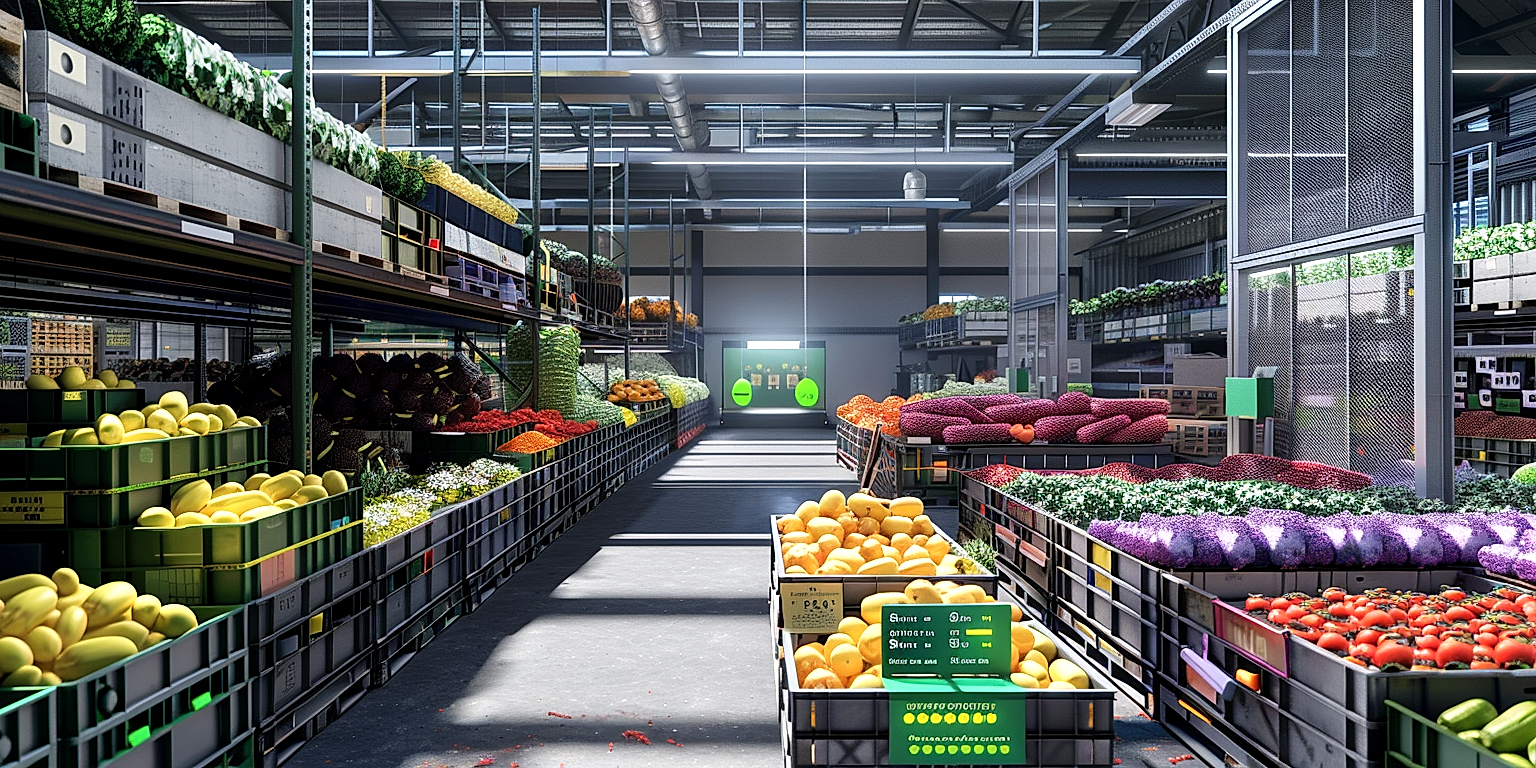Improving supply chain resilience has become a top priority in the produce processing industry.
Unforeseen circumstances, such as weather events, disease outbreaks, and transportation disruptions often pose significant challenges.
These hurdles underscore the necessity to enhance the robustness and flexibility of these crucial networks.
Adopting strategies to bolster resilience helps to anticipate, cope with, and recover from potential crises.
This article dives into several effective methodologies designed for this purpose.
It offers insights to help businesses mitigate the risks of disruption and improve overall operational efficacy.
Contents
- Ways To Build Resilience In Produce Processing Supply Chains
- 1. Implement advanced tracking and tracing technology
- 2. Create diverse sourcing and distribution networks.
- 3. Train Staff on Supply Chain Management
- 4. Invest in Flexible, Scalable Production Equipment
- 5. Enhance forecasting and inventory management
- 6. Boost warehouse and storage capabilities.
- 7. Establish Crisis Management Protocols
- 8. Implement quality control procedures
- 9. Foster strong supplier and customer relationships
- 10. Utilize AI for predictability and optimization.
- The Bottom Line
Ways To Build Resilience In Produce Processing Supply Chains
1. Implement advanced tracking and tracing technology
Within the produce processing supply chain, one substantial method for building resilience is the implementation of advanced tracking and tracing technology.
Advancements in tracking technology systems have enabled improved visibility, sustained control, and maximized efficiency within supply chains, across various industries.
For the produce processing sector particularly, a robust tracking system is critical due to the unique challenges associated with fresh produce, such as stringent food safety regulations, perishability, and seasonality issues.
Real-time tracking and tracing technology allows for the instantaneous location of products, ability to anticipate delays, and the reduction of estimated arrival times.
By leveraging modern tracking and tracing solutions, produce processors can ensure the accuracy, integrity, and safety of their products from the field to the consumer’s plate.
This exemplifies technological advancement not as an optional luxury, but as a necessary tool for ensuring the efficiency and resilience of a produce processing supply chain.
Furthermore, these technologies also provide the key advantage of product traceability which is an important aspect for quality assurance and consumer safety.
A robust tracing system allows for quick identification and isolation of any safety issues, minimizing the risk of widespread, expensive recalls.
This is particularly crucial in the produce industry where food safety and integrity are paramount, thus, the strategic application of traceability within the supply chain significantly boosts resilience.
Additionally, advanced tracking technology facilitates better collaboration between different areas within the supply chain, enhancing its overall functionality.
This increased connectivity allows operators to proactively respond to potential issues, from supply disruptions to logistical bottlenecks, thereby improving supply chain resilience.
Moreover, emerging technologies such as IoT (Internet of Things), blockchain, RFID (Radio Frequency Identification), and AI (Artificial Intelligence) can further elevate tracking and tracing capabilities.
Such technology provides real-time, accurate data, allowing produce processors to dynamically adjust to any changes, further bolstering resilience and preventing product loss.
Emerging technologies also enhance transparency across the entire supply chain, providing all involved stakeholders with accurate information about the products’ current state and history.
This level of transparency builds trust and confidence among consumers, elevates brand reputation and contributes to a stronger, more resilient supply chain.
Overall, the strategic implementation of advanced technologies to track and trace products throughout the entire supply chain is a powerful solution for improving operational efficiency, as well as building resilience in produce processing supply chains.
2. Create diverse sourcing and distribution networks.
One notable step in building resilience in produce processing supply chains is to create diverse sourcing and distribution networks.
Reliance on single-source suppliers or distribution networks can leave your supply chain vulnerable to disruptions.
Disruptions can pop up from various fronts, such as cross-border restrictions, supplier bankruptcy, or extreme weather conditions.
Having a more varied source and distribution strategy can alleviate these vulnerability concerns.
Expanding your supplier base would ensure that if one supplier encounters an issue, you can swiftly switch to another without significant downtimes.
Moreover, having multiple distribution networks cushions your business against unexpected logistics issues.
Diverse sourcing strategies and numerous distribution networks significantly lessen the impact of disruptions and ensure a more stable supply chain.
Another reason to diversify your sourcing and distribution networks is to reduce dependency on particular regions or providers.
Politics, regulations, exchange rates, and local circumstances can pose challenges to supply chain continuity.
Multiple sourcing and distribution channels empower your operations, giving you choices and flexibility during demanding times.
A wider network also enables more agility in response to market changes or customer demand.
Additionally, a broader base of suppliers and distributors foster healthy competition, leading to better prices, product availability, and service levels.
This competitive dynamic is a key enabler in maintaining the strength and integrity of your supply chain.
However, diversifying sourcing and distribution comes with its own set of challenges and complexities.
These might include having to manage more relationships, ensure consistent product quality, and handle varying lead times among different suppliers.
But, the benefits of diversification, in building resilience into your produce processing supply chains, outweigh the challenges.
3. Train Staff on Supply Chain Management
Training your staff on supply chain management is an imperative step towards creating more resilience in your produce processing supply chains.
By boasting a team that is well-equipped with supply chain information, you are securely backing your organization with a deep understanding about each link that forms your supply chain.
Training employees on the nitty-gritty of supply chain management arms them with the ability to not just execute but to also interpret, analyze and foresee potential issues and disruptions.
This kind of comprehensive knowledge not only enhances the workers’ skill set but also enables them to contribute towards making the supply chain process more efficient.
Training should not be a one-time activity. Continuous learning and development programs should be placed to keep the staff updated about the latest technologies and systems.
These could include workshops on data analytics, advanced tracking technologies, inventory management, and lean processing techniques.
Training should also focus on creating an understanding about factors that might disrupt the supply chain, risk management techniques, and developing contingency plans.
Case-based learning and real-life problem solving could be incorporated into the training sessions for the staff to learn from practical scenarios.
It’s also beneficial to create a culture of open brainstorming sessions to encourage all team members to share ways to enhance the supply chain’s performance.
Keep in mind that while there is an associated expenditure with staff training, it is a strategic investment that pays for itself in terms of delivering a more resilient and efficient supply chain.
The saying ‘knowledge is power’, in this context, could be better stated as ‘knowledge is resilience‘.
Since the staff themselves are an integral part of the supply chain, their knowledge, skills, and abilities directly influence the overall performance of the supply chain.
Empowered and knowledgeable staff could be the key differentiator between efficiently handling a crisis situation or succumbing to it in your produce processing supply chain.
Such training programs will not only help in improving the overall productivity of the supply chain but also instill a sense of ownership and responsibility in the staff, thus, making them more pro-active in identifying and mitigating risks.
Remember, a well-trained, informed staff could be your first line of defence against any disruptions or vulnerabilities in your produce processing supply chains.
4. Invest in Flexible, Scalable Production Equipment
Investing in flexible, scalable production equipment should be a top priority for businesses striving to build resilience in your produce processing supply chains.
This is not just about buying new machinery, but considering the capacity of that machinery to adapt and scale, depending on the needs of the operations.
Let’s consider a large produce processing plant that depends on a singular, complex piece of production equipment.
If that equipment breaks down or needs maintenance, this could lead to a significant loss in production capabilities, causing breakages in the supply chain.
In contrast, investing in modular production equipment that can expand or contract based on current needs, can help reduce these issues and maintain stability in the supply chain.
Alongside this, it’s also essential to look at flexibility in terms of production processes.
Investing in equipment that allows you to switch between different products or packaging types quickly can be a lifesaver when facing disruptions in the supply chain.
This level of flexibility provides resilience in times of fluctuating demand or when there are changes in the availability of certain products.
Moreover, there is a growing trend towards automation in production processes.
This not only increases efficiency but also allows for better scalability, as automated processes can be easily upgraded or replicated based on demand.
Funds towards automation can also future proof your operations, enabling you to better cope with sudden changes in the market dynamics or labor availability.
On top of all this, the use of smart production equipment, embedded with sensors and connected to the internet (IoT), is paving the way for predictive maintenance.
This means that potential issues can be identified and addressed before they result in downtime.
For instance, a sensor could detect a subtle change in the performance of a piece of equipment, triggering a predictive maintenance protocol to kick-in, thus avoiding a costly disruption in the supply chain.
Finally, by investing in flexible, scalable production equipment, you not only create a more adaptable and efficient supply chain but also position your business to seize new opportunities as they arise.
In essence, investing in the right production equipment and technologies is about making your supply chain more resilient and less vulnerable to shocks and disruptions.
5. Enhance forecasting and inventory management
Understanding the importance of enhancing forecasting and inventory management in a produce processing supply chain is crucial to building resilience.
Effective forecasting methods allow companies to anticipate demand and prepare their supply chains accordingly.
With precise forecasting, one can optimize inventory levels, minimizing wastage and ensuring that customer demand is met.
Besides, improved forecasting accuracy in the produce processing industry can lead to a reduction in stockouts and overstocks.
Having a well-managed inventory system, in turn, helps to keep costs under control and maintain high customer satisfaction levels.
Further, inventory management is not just about monitoring current stock levels, but also involves keeping a close eye on the rate of produce turnover.
This can help you identify patterns and make sound business decisions with regard to procurement and distribution.
Advanced forecasting and inventory management systems use sophisticated algorithms and data analysis to predict future demand, identify trends, and plan for fluctuation periods.
Technological advancements such as artificial intelligence and machine learning can also be leveraged to enhance forecasting accuracy and optimize inventory management.
In addition, good inventory management in the produce processing industry should also consider seasonality and perishability of products.
These factors play a crucial role in determining the shelf-life of products and the speed at which they need to be processed and distributed.
By enhancing forecasting and inventory management in your supply chain, you can create a robust and resilient system that can weather fluctuations in demand, supply disruptions, and other potential challenges.
Finally, regular audits and reviews of your inventory management systems and policies can help to ensure they remain effective and efficient.
It is important to remember that enhancing forecasting and inventory management is a continuous process that needs regular attention and improvement.
Your ultimate goal should be to build a resilient supply chain that can adapt quickly to changes and ensure smooth and efficient operations even in challenging circumstances.
6. Boost warehouse and storage capabilities.
One key way to build resilience in produce processing supply chains is to boost warehouse and storage capabilities.
Storage and warehousing are a vital component of supply chains, and investing in these areas can help address a myriad of challenges faced in the produce processing industry.
This can be achieved through a variety of methods such as increasing warehouse capacity, improving storage conditions, and implementing smarter warehousing technologies.
Investing in efficient storage solutions can help businesses minimize waste, reduce costs and prevent losses which are especially important given the perishable nature of produce.
The storage capabilities of the warehouse need to be highly flexible to adapt to the changing demands and ensure the safety and freshness of the produce.
Advanced technology in storage such as cold chain facilities is an effective way of prolonging the shelf life of produce and preventing spoilage.
Efficient warehouse management can make a significant difference in reducing the time it takes to move produce from the farm to the consumer’s table, as well as ensuring that the produce arrives in the best possible condition.
Creating a robust warehouse system will require comprehensive planning, analysis of storage needs, evaluation of current capacities and future requirements.
By building additional infrastructure and improving warehouse design, businesses can enhance storage and warehousing capabilities to effectively manage their inventory.
A huge benefit of boosting warehouse and storage capability is the possibility of expanding market reach.
With a larger storage capacity, a business can store more produce, thereby able to accept larger orders and meet increased demand during peak seasons.
Moreover, enhanced warehouse and storage capabilities can contribute to improved operational efficiency and customer satisfaction owing to the speedier processing and delivery of orders.
With improved capabilities, a company can reduce the risk of stockouts and create an efficient flow of products from storage to distribution which is crucial in supply chain resilience.
We must not forget that warehouse and storage improvement also includes investing in the right warehouse management system (WMS).
WMS helps in managing and controlling inventory, shipment, and even labor in warehouses effectively and efficiently.
In the grand scheme of things, the goal is not just to boost warehouse and storage capabilities, but to make all elements of the supply chain lean, robust, and resilient even in the face of unforeseen circumstances.
7. Establish Crisis Management Protocols
In the fast-paced world of produce processing supply chains, it is crucial to establish robust crisis management protocols.
Having robust crisis management protocols in place provides assurance that if a disruption does occur, it can be handled efficiently and effectively.
This is especially beneficial in minimizing downtime, thereby reducing potential losses.
When a crisis occurs, having detailed, pre-established protocols allows immediate action, reducing the risk of substantial negative impacts on the supply chain.
To start, a comprehensive risk assessment should be carried out to identify potential hazards and threats specific to the produce processing industry.
Identifying these risks allows the formulation of contingency plans tailored to manage each specific threat.
An effective crisis management protocol should incorporate strategies for risk mitigation to lower the possibility of a crisis happening in the first place.
This can be done through measures like routine maintenance of equipment, rigorous quality control checks, and maintaining a diversified network of suppliers and distributors.
When a crisis situation arises, having a clear, accurately communicated chain of command is critical.
Knowing who is responsible for making crucial decisions under pressure, and who will communicate these decisions to other relevant parties, is essential to effectively manage the crisis.
Along with the establishment of a command chain, it’s extremely important to create a crisis communication strategy.
This creates a clear pathway for the distribution of accurate information during a crisis situation, keeping stakeholders informed and providing reassurance.
A robust crisis management protocol should also include regular training for staff.
This equips them with the skills and knowledge to respond appropriately during a crisis, increasing the overall resilience of the supply chain.
Finally, following the resolution of a crisis, it’s essential to review and update the crisis management protocols.
By analyzing the response and identifying any areas for improvement, the supply chain can continue to become more resilient and prepared for future threats.
Establishing comprehensive crisis management protocols is an integral component in building resilience in produce processing supply chains, thereby ensuring continuity and consistency in operations.
8. Implement quality control procedures
The process of building resilience in produce processing supply chains heavily relies on the implementation of effective and efficient quality control procedures.
Fundamental to any supply chain’s effectiveness is the consistency and quality of the goods being transported, processed, and delivered.
By implementing stringent quality control procedures, businesses in the produce processing industry can help ensure that their products meet the highest industry standards at all times.
In the produce processing industry, quality control procedures should address factors such as product freshness, contamination risk, and product consistency.
Integrating these crucial factors into quality control processes can help prevent produce spoilage, contamination, bolster consumer confidence, and reduce potential supply chain disruptions.
Objective quality control procedures provide a systematic approach to identifying and rectifying problems before they escalate into bigger, more costly disruptions for the business.
Moreover, quality control systems enable businesses to learn more about their production processes, allowing them to make necessary improvements.
For instance, if a certain batch of produce consistently fails to meet quality standards, the company can investigate the source of the problem, be it poor growing conditions, inappropriate transportation, or inadequate storage systems.
This allows businesses to address problems at their source, leading to improved production outcomes and greater resilience in their supply chain.
Furthermore, implementing a rigorous quality control program often necessitates the development of comprehensive documentation of procedures and policies.
This documentation plays a crucial role in the consistent application of quality control measures across the entire operation.
With proper documentation, training, and execution, quality control procedures can increase consistency and reliability in the produce processing supply chain.
In addition, quality control systems can increase compliance with food safety regulations, reducing the likelihood of costly recalls and loss of consumer trust.
Targeted quality control measures can also improve customer satisfaction by ensuring that the end product meets or exceeds consumer expectations.
Overall, implementing quality control procedures in the produce processing supply chain is not just about maintaining product standards – it’s about building a resilient, adaptable, and reliable operation that can weather the inevitable storms and disruptions that come in any business venture.
To conclude, while it requires an investment of time and resources, the establishment and maintenance of these procedures is crucial in mitigating risks and developing a strong, resilient supply chain capable of meeting the demands of a dynamic and unpredictable marketplace.
9. Foster strong supplier and customer relationships
One of the most effective ways to build resilience in produce processing supply chains is through fostering strong relationships with both suppliers and customers.
The bond between suppliers and businesses is an essential part of a supply chain, and maintaining this relationship can significantly improve the resilience of your operations.
When faced with unexpected challenges, strong supplier relationships can be beneficial as they provide more flexibility and understanding in finding solutions.
Suppliers who value their relationship with your business are more likely to prioritize your needs and make accommodations that can help your business remain operational under difficult circumstances.
Maintaining great relationships with your suppliers can not only improve the reliability of your supply chain but also its resilience, getting through tough times easier together.
On the other side, customer relationships are equally important for resilience.
Understanding customer needs and maintaining open communication allows for more accurate forecasting and planning.
A strong relationship with customers can foster loyalty, meaning they may be more understanding and patient during periods of disruption.
This loyalty and patience can free up much-needed resources for your business to focus on addressing the issue at hand, rather than worrying about losing business.
Furthermore, customers who have a close relationship with your business are more likely to provide valuable feedback, which can be essential in improving your business operations and supply chain resilience.
For example, they may provide suggestions for new products or services that fulfil a niche in the market, or they may be able to suggest areas where your business could improve efficiency and reduce potential bottlenecks in your supply chain.
Investing time and resources in maintaining strong relationships with both suppliers and customers can significantly enhance the resilience of your produce processing supply chain.
It can help you plan for and address potential challenges, adapt to changes more quickly, and ultimately keep your business running smoothly even in times of difficulty.
Remember, all parties in the supply chain are working towards the same goal of getting the product from the field to the fork, and strong relationships can make this process significantly more resilient.
It is clear that the networks created between suppliers, businesses, and customers form the backbone of a resilient supply chain in the world of produce processing.
10. Utilize AI for predictability and optimization.
Increasingly, advanced technologies like Artificial Intelligence (AI) are being utilized in the supply chain industry, particularly in produce processing supply chains.
The integration of AI in these supply chains brings about a transition towards more predictable and optimal systems.
AI is a powerful tool that can forecast demand with high accuracy, even in complex supply chains with numerous variables.
Predicting future demand is crucial for optimized inventory management and production planning.
This utilization of AI allows companies to cut costs by reducing waste and inefficiencies.
By predicting exactly how much produce to process and when, companies can pinpoint the perfect amount, thereby avoiding overproduction and waste.
Moreover, AI algorithms can identify patterns and trends, predicting potential supply chain disruptions before they occur.
This proactive approach allows businesses to take appropriate measures beforehand, improving their resilience in the face of potential disruptions.
Further, AI can also aid in the optimization of distribution networks by efficient routing of deliveries, essentially decreasing fuel costs and emissions.
Utilizing AI for predictability and optimization, therefore, contributes significantly to the building of resilience in produce processing supply chains.
Companies need to consider investing in AI infrastructure and expertise for their supply chains to stay ahead of their competition.
Bringing AI into their supply chains not only gives these companies a competitive edge but also equips them to adeptly handle unexpected challenges.
AI systems are constantly learning and adapting from data, and as such, their predictions and optimizations only get better over time.
This continuous improvement is assured by AI, guaranteeing long-term resilience of the supply chain.
It must be noted that while the implementation of AI demands substantial investment, the benefits it brings to produce processing supply chains certainly justify the investment.
The Bottom Line
After elaborating on the various strategies to boost supply chain resilience, it is clear that these measures are instrumental for any business that seeks to thrive in the current volatile economic landscape.
Advancements in tracking technology, diverse distribution networks, staff training, investment in adaptable production equipment, improved forecasting, and enhanced warehousing are all vital aspects.
Furthermore, establishing crisis management protocols, implementing quality control measures, nurturing strong supplier and customer relations, and utilizing AI for prediction and optimization altogether form a comprehensive blueprint for supply chain resilience.
These approaches not only insulate businesses from disruptions but also provide a competitive edge and potential for growth in the ever-evolving marketplace.




